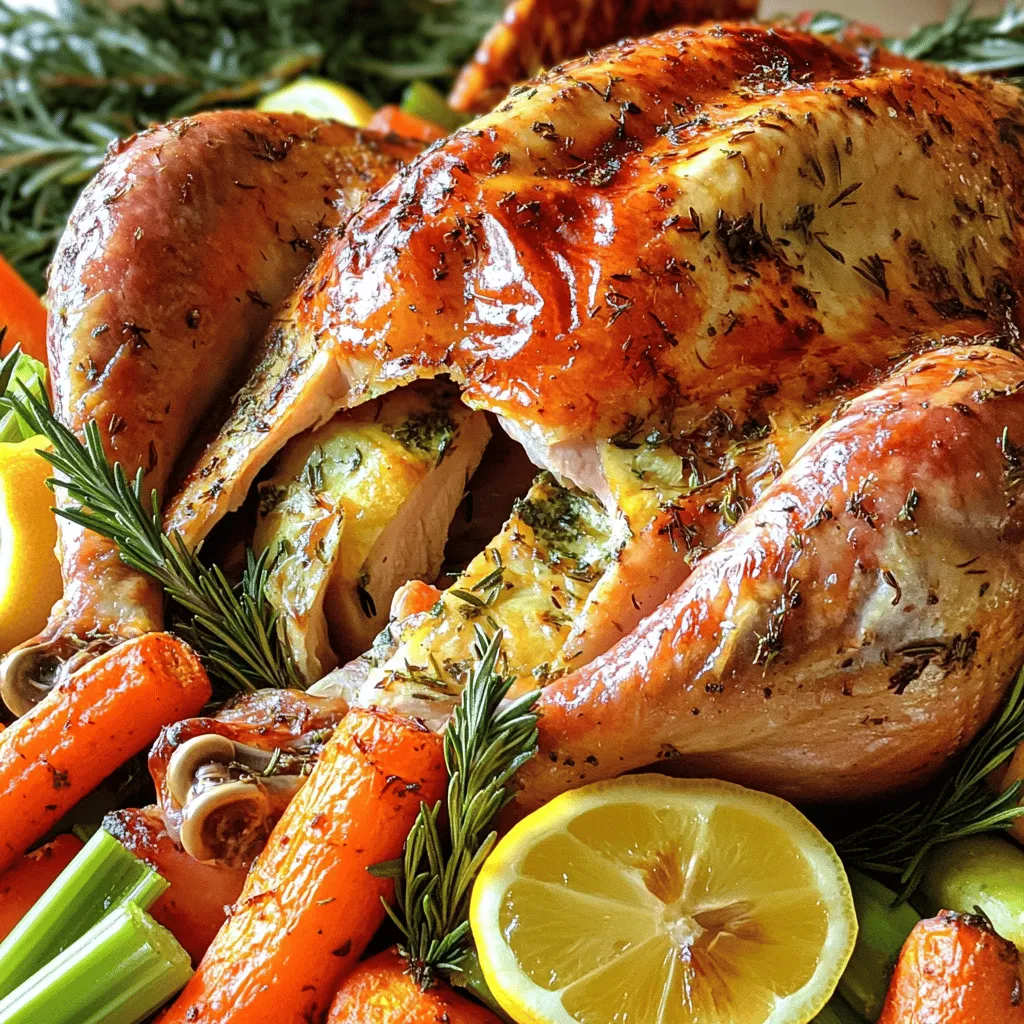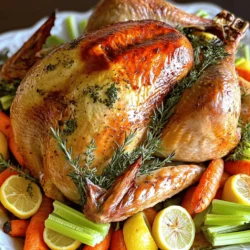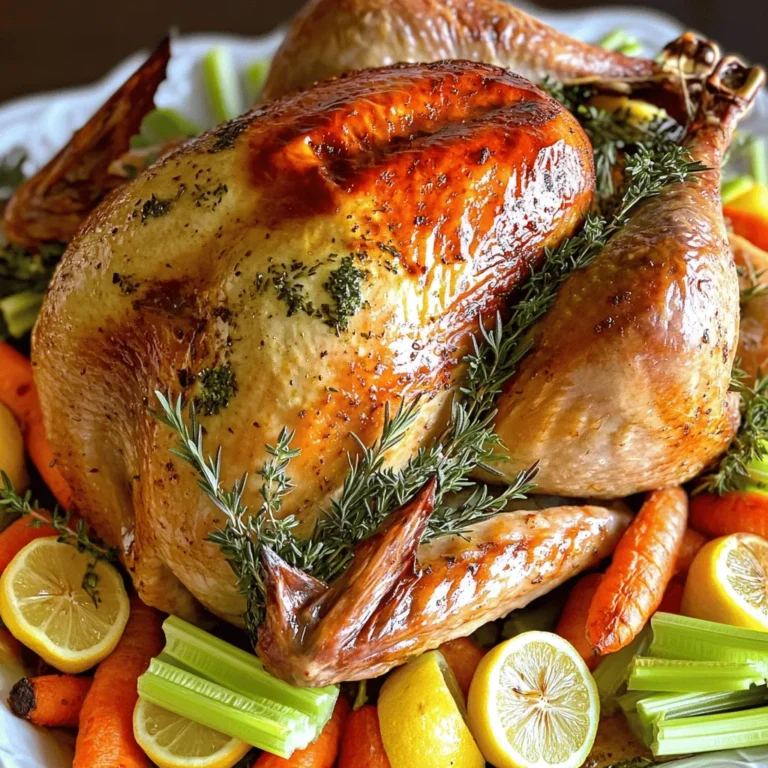Ready to take your turkey game to the next level? In this guide, I’ll show you how to make a boss-level roast turkey that is not only flavorful but also juicy. From choosing the right ingredients to perfect cooking techniques, every detail matters. Let’s create a show-stopping centerpiece for your next meal that will impress your family and friends. Your perfect turkey awaits!
Ingredients
List of Required Ingredients
- Whole turkey (12-14 lbs)
- 1/2 cup unsalted butter, softened
- 2 tablespoons olive oil
- 1 tablespoon garlic powder
- 1 tablespoon onion powder
- 1 tablespoon smoked paprika
- 1 tablespoon fresh rosemary, chopped
- 1 tablespoon fresh thyme, chopped
- 1 tablespoon fresh sage, chopped
- 2 teaspoons salt
- 1 teaspoon black pepper
- 4 cups low-sodium chicken broth
- 1 lemon, halved
- 1 onion, quartered
- 4-5 garlic cloves, smashed
- 2 cups carrots, chopped
- 2 cups celery, chopped
- Fresh herbs for garnish (rosemary, thyme, and sage)
Ingredient Substitutions
- You can use canola oil instead of olive oil.
- If fresh herbs are not available, dried herbs will work fine. Use less.
- Carrots and celery can be swapped with parsnips or onions for roasting.
Quality of Ingredients
- Always choose fresh herbs. They make a big difference in flavor.
- Ensure your turkey is fully thawed. A frozen turkey will not cook well.
Step-by-Step Instructions
Prepping the Turkey
1. Remove giblets and bring to room temperature: Take out the giblets from the turkey’s cavity. These are often in a bag. Let your turkey sit out for about 30 minutes. This helps it cook evenly.
2. Preheat oven and prepare roasting equipment: Set your oven to 325°F (165°C). Get a large roasting pan and a rack. The rack keeps the turkey off the pan and allows air to flow.
Making the Herb Butter
1. Combining ingredients for the herb mix: In a bowl, add 1/2 cup of softened butter. Mix in 2 tablespoons of olive oil. Then, add garlic powder, onion powder, smoked paprika, and chopped herbs. Use 1 tablespoon each of rosemary, thyme, and sage. Don’t forget 2 teaspoons of salt and 1 teaspoon of black pepper.
2. Techniques for enhancing flavor: Mix everything until smooth. This butter will keep the turkey juicy and add great taste. You can use a whisk or a fork for this.
Seasoning and Stuffing
1. Proper techniques for herb application: Gently lift the skin of the turkey. This is where you will rub half of the herb butter. Use your fingers to spread it under the skin. Then, coat the outside with the rest of the butter for a nice, crispy skin.
2. Packing the cavity for maximum flavor: Stuff the cavity with lemon halves, quartered onion, smashed garlic, and fresh herbs. This adds great flavor as the turkey cooks.
Roasting Process
1. Setting up the roasting pan: Spread chopped carrots and celery in the bottom of the pan. Place your turkey on the rack above the veggies. Pour low-sodium chicken broth into the pan until it’s about 1 inch deep.
2. Timing and basting methods: Cover the turkey loosely with foil. Roast it for about 2.5 hours. Baste the turkey every 30 minutes with the pan juices. After 2.5 hours, remove the foil to crisp the skin. Cook until the thickest part of the breast reaches 165°F (74°C).
Rest and Carve
1. Importance of resting time: Once the turkey is done, take it out of the oven. Let it rest for 20-30 minutes. This allows the juices to settle. A rested turkey is always juicier.
2. Techniques for flavorful carving: Use a sharp knife to carve the turkey. Start with the breast and move to the legs. Serve the turkey on a platter with the roasted veggies. Drizzle some pan juices over the top for added flavor.
Tips & Tricks
Cooking Tips for Perfect Turkey
To get a juicy turkey, always check the internal temperature. Use a meat thermometer. Insert it into the thickest part of the breast and thigh. The turkey is done when it reaches 165°F (74°C). This step keeps the turkey safe and tasty.
If you want a different flavor, try other roasting methods. You can spatchcock the turkey for faster cooking. This means removing the backbone so it cooks flat. You can also smoke the turkey for a unique taste. Each method gives a different texture and flavor.
Basting Techniques
Basting makes your turkey moist and flavorful. I recommend basting every 30 minutes. This keeps the skin from drying out. Use the pan juices or melted butter for basting.
For added flavor, you can mix herbs or spices into the basting liquid. Try adding a splash of lemon juice or some garlic. This enhances the taste and makes every bite special.
Presentation Ideas
A great-looking turkey impresses your guests. Use fresh herbs like rosemary and sage for garnish. Place them around the turkey on the platter. This adds color and a fresh smell to your dish.
When serving, consider pairing your turkey with cranberry sauce and your favorite sides. Arrange the sides on the table for a beautiful feast. A well-presented meal makes the occasion memorable.

Variations
Flavor Profile Adjustments
You can change the flavors of your roast turkey by using different spices. Try using cumin or coriander for a warm touch. If you want a sweeter flavor, add cinnamon or nutmeg. You can also mix in some fruit or nut flavors. Dried cranberries or apricots can add a nice sweetness. Chopped nuts like pecans or walnuts can give a crunchy texture.
Cooking Methods
You can cook your turkey in different ways. Oven roasting is classic and easy. Deep frying makes the skin very crispy and is a fun option. If you like smoke, try smoking your turkey. You can use a grill for a fun outdoor cooking experience. Each method gives a unique taste and texture.
Side Dish Pairings
Pair your roast turkey with great sides. Mashed potatoes and stuffing are traditional favorites. Green beans or roasted Brussels sprouts add color and flavor. For a lighter option, try a fresh salad. If you want vegetarian or vegan sides, roasted vegetable platters and quinoa salad work well. These dishes enhance the turkey’s flavors and make a complete meal.
Storage Info
Storing Leftover Turkey
To keep your leftover turkey fresh, follow these steps:
- Refrigeration: Place leftover turkey in an airtight container. It should cool down to room temp before sealing. Store in the fridge for up to four days. Always label the container with the date.
- Freezing: If you want to save turkey longer, freeze it. Cut it into smaller pieces for easier thawing. Wrap each piece tightly in plastic wrap, then in foil. Use freezer-safe bags or containers to prevent freezer burn. Frozen turkey can last for up to six months.
Reheating Methods
When it’s time to enjoy your leftover turkey, reheating is key. Here are some great tips:
- Keep it moist: Preheat your oven to 325°F (165°C). Place turkey pieces in a baking dish. Add a few tablespoons of broth or water. Cover with foil to trap steam. Heat for 15-20 minutes, or until warmed through.
- Creative uses: Leftover turkey is great in many dishes. You can make turkey sandwiches or salads. Add it to soups or casseroles. You can also use it in tacos or stir-fries for a fun twist.
By following these storage and reheating tips, you ensure your Boss-Level Roast Turkey remains flavorful and juicy even days after your feast.
FAQs
How long to cook a turkey per pound?
You should cook a turkey for about 13-15 minutes per pound. For a 12-14 lb turkey, this means 2.5 to 3.5 hours. Always check the turkey’s internal temperature. It should reach 165°F (74°C) in the thickest part of the breast and thigh. Use a meat thermometer to ensure accuracy. This way, you avoid undercooking or overcooking the bird.
What to do if the turkey is not thawed?
If your turkey is not thawed, you can use cold water to thaw it safely. Keep the turkey in its original packaging. Submerge it in cold water, changing the water every 30 minutes. Allow about 30 minutes per pound for this method. Or, you can cook the turkey from frozen, but it will take 50% longer. Make sure to check the internal temperature as it cooks.
How to tell if the turkey is fully cooked?
To know if your turkey is done, check the internal temperature with a meat thermometer. Insert it into the thickest part of the breast and thigh, avoiding the bone. The turkey is safe to eat when it hits 165°F (74°C). Another sign is the juices. They should run clear when you pierce the thigh with a fork. If they are pink, it needs more cooking.
Can I prepare the turkey a day in advance?
Yes, you can prep the turkey a day ahead. Season the turkey with the herb butter and cover it. Allow it to sit in the fridge overnight. This helps the flavors soak in. On roasting day, take the turkey out and let it rest at room temperature for 30 minutes. This helps it cook evenly.
What other seasonings can I use?
Feel free to mix up the flavors! You can use herbs like oregano, basil, or dill. Spices like cumin or coriander add warmth. For a sweet touch, try honey or maple syrup. Citrus zest or even apple slices can brighten the flavor. Don’t forget to adjust the salt. This gives you a unique turkey every time you cook.
In this blog post, we explored how to make a perfect turkey. We covered required ingredients, cooking techniques, and elaborate serving ideas. Remember, fresh herbs and the right seasonings make a big difference. The roasting process and resting time are key for best results. With the tips provided, you can create a delicious meal. Enjoy your cooking journey, and impress your guests with your turkey skills!


